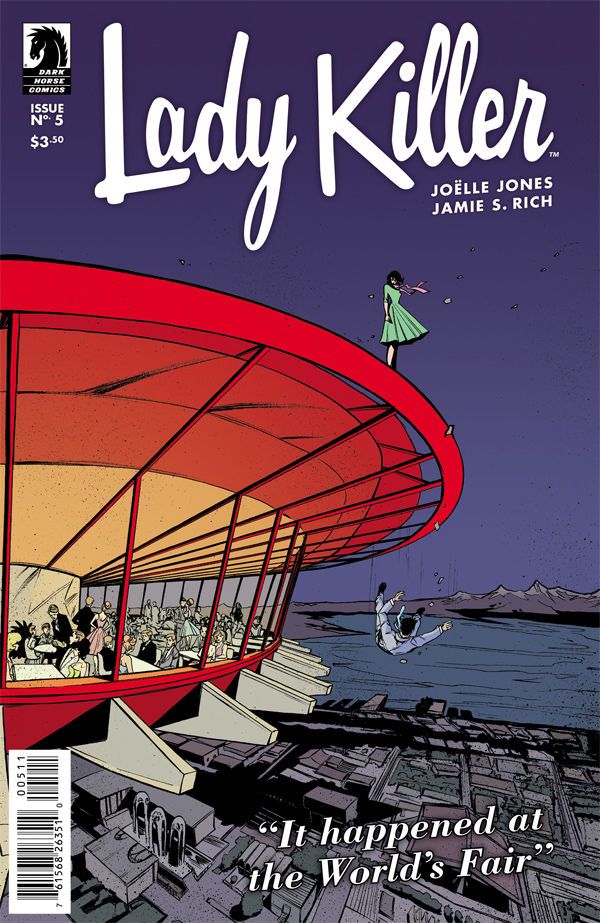"Lady Killer" #5 by Joelle Jones and Jamie Rich wraps up the story with nonstop action as Josie and Ruby go up against five men, all trained killers like themselves. There's not a dull moment and transitions are seamless. Jones is able to make carnage look elegant.
The issue flies by but, upon rereading, the action has its flaws. There's a classic "pinch" at the beginning of the issue when Josie's family shows up. This is too obvious a move. It mechanically reminds readers of the stakes but is too predictable to generate suspense. Peck's "no guns" rule was a little too convenient, and it was excessively dumb for Peck's men to rush Josie one by one instead of trying for some kind of teamwork. While it's amusing to watch everyone fight in suits, no pencil skirt would ever allow enough mobility for a kick without ripping or sliding farther up. Despite these faults in realism, the action still works as a whole. "Lady Killer" #5 has a tone and style like that of Tarantino's films, where the sheer contrast of choreographed, hyper-intense violence against a clean backdrop generates its own beauty and suspense. The combat scenes are worth reading just to see how Jones' graceful line can contain a Kirby-esque level of energy.
The Seattle World's Fair is a colorful setting, but it doesn't play an active role in the plot beyond providing unusual props and a pretty backdrop. Jones and Rich use a newscast-style voiceover to emphasize the irony of peaceful hopes for technology research in the age of the Cold War. The irony also foreshadows the more immediate bloodshed to come. The setting provides period flavor and some extra tension, but too little of it connects up with Josie's story to justify the amount of text devoted to it.
Jones maintains the period detail in the art, but most of the interior pages aren't as breathtaking and intricately composed as the cover image. Allred's color work is flat and saturated as usual, but she overuses grays and warm reds throughout the issue, with a few exceptions, like the colorful sign for the tower. Jones has beautiful background details like the mirrored cube ceilings and bull's-eye designs on the walls. Allred mutes and flattens these textures instead of bringing them out. The mint green and orange-red on the cover are a perfect pairing of complimentary colors, but the interiors don't get the same care.
The plot and shape of the conclusion are predictable. It's satisfying to see Peck and Stenholm get what they deserve, but they were smug cardboard villains to begin with, good as dead when they refused to take "no" for answer. Even for Josie and Ruby, the heroines, characterization also never goes beyond the superficial. This is typical for a miniseries, but Jones and Rich also never achieve the pathos and resonance necessary to make a deeper impression.
If there's a message hidden in this thriller, it's that a woman should be able to choose. The sly, ironic ending allows Josie closure and reward. She's given a narrow but welcoming path to reintegrate her identity. However, this understanding sits in the background, while the melodramatic and predictable tension of a double life dominates.
Given their historical inspiration and themes, Joelle and Rich play it too safe. They are well-informed about Friedan's "The Feminine Mystique" and the historical milieu, but their treatment of philosophical and psychological themes is superficial. Josie's story arc follows the dream of choice feminism, a variety of third-wave feminism that clashes with the less flexible ethos and more revolutionary stakes of 1960s second-wave feminism.
Josie's old job is the dark side to her Stepford-like appearance. Her anger and most of her mind is hidden when it's not put to use by the job. All underlying tensions about the claustrophobia of home, agency and identity, anger and repression are indistinctly felt because the thrill of combat and gore are prioritized over the quieter horror of women's limited options. Shying away from direct engagement with feminism may be a wise choice, since didacticism can easily destroy fun, but the creative team's failure to play that card (instead of just showing the reader that they had it in their deck) weakens the potential impact.
It's too easy to ignore the subtext, and many readers will miss it entirely. Despite this focus on entertainment over more memorable substance, "Lady Killer" is an enjoyable and worth picking up for the Jones' art.

